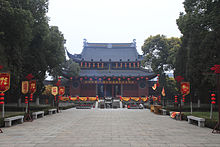Chinese folk religion
Chinese folk belief (also called Chinese folk religion or shenism) is the term used to describe the mixture of partly religious and partly non-religious practices prevalent in areas inhabited by Chinese. This faith has no theology of its own, there is no clergy or organization, the father of the family celebrates the rites with the extended family such as wedding rites, New Year rites, etc. The term Chinese folk faith is only used abroad, because there is no Chinese term for it.
Among the general population - especially in rural areas - there is a belief that there is an invisible sphere of spirits (shen), which are powerful in different ways. This belief is diverse and cannot be clearly distinguished from other religions and world views prevalent in Asia. It combines elements of ancestor worship, local cults (such as Manchurian shamanism in the Northeast), Buddhism, Daoism and Confucianism, folk beliefs, geomancy and Fengshui (see also: Syncretism and Three Teachings). There are very many geographical variations and peculiarities.
The afterlife is considered to be interwoven with this world and strongly resembles it. Communist and capitalist ideas later found their way into the Chinese world of belief, which was shaped by considerations of utility. Confucianism (and today capitalism and communism) usually serve as a guide for daily life, Daoism is useful for exorcism and purification, for funerals one turns to Buddhist priests.
In the rites and practices, religious ideas, philosophy, or simply respect for the ancestors cannot be precisely distinguished; Chinese folk belief is therefore not a religion in the Western sense. The practices and beliefs that make up Chinese folk beliefs are among the foundations of Chinese culture. It is therefore almost impossible to give numbers of followers, because many people who claim not to be religious nevertheless worship their ancestors and participate in rites. The Chinese Society of Purdue University gave the following estimates in 2010 based on a wide-ranging survey:
- 754 million people practice some form of ritual ancestor worship
- 362 million people have practiced fortune-telling and the like in one year.
- 215 million people believe in ancestral spirits
- 145 million people have applied Fengshui within one year
- 141 million people believe in the god of wealth
At the heart of Chinese popular belief is the veneration of ancestors (ancestor worship) and local deities. Honoring ancestors in China, however, does not necessarily have to be religiously based, but can also be done simply out of respect. In many Chinese households, especially in the countryside, there is a table or cabinet in a central place on which there are pictures or statues of ancestors, deities or important public figures. In the People's Republic of China, this may include pictures of Mao Zedong or Deng Xiaoping. Fruits, for example, are offered to the ancestors. In the countryside there are often ancestral halls where names and pictures of important ancestors are displayed. These ancestral halls were temporarily no longer to be found in the People's Republic, but their importance is now increasing again, especially in villages where a large proportion of the inhabitants have the same ancestors.
The deities of Chinese folklore are persons of male or female gender who really once existed and who are said to have special powers or deeds. These deities cannot be compared to Buddha or Guanyin (the goddess of compassion) in terms of their power, but are responsible for limited areas such as the oven, the front gate or war. Mao Zedong is also considered in part as a person who has already entered the Olympus of Chinese deities.
Occasionally, statues of the so-called "Three Stars" Fu, Luk and Sau are also seen in the west.
According to the imagination of believers, these deities can fulfill wishes or help solve problems. The believer prays to the statue or the image of the respective deity and holds one or more incense sticks in his hand. The prayer contains the request and also the promise of a (symbolic) return. The prayer is carried out in kneeling or under constant bowing and is finished by putting the incense sticks into vessels set up for this purpose. If the believer feels that the deity will take care of this wish, an offering is made by offering food or burning imitation money. If the believer has the feeling that the deity does not feel responsible for the wish, he can always try another god. Sometimes Buddha statues are erected at the same time.
A central point in Chinese folk beliefs is also the healing of the sick. Healers usually have no training, nor is there any characteristic that distinguishes them from other citizens. For the purpose of healing the sick, sometimes exorcism is used, sometimes confession of sins, and sometimes the administration of herbs. In the countryside, where there are no doctors who treat according to traditional Chinese medicine or Western medicine, this kind of healing art is sometimes the only possible way out. Otherwise, the art of healing according to folk beliefs can also be used as a complement to other methods of treatment.
_in_central_Taiwan.jpg)
Procession with a local god in Taiwan.
_Taoist_Temple_at_Tianchi_(Heavenly_Lake)_in_Fukang,_Changji,_Xinjiang.jpg)
Temple of Happiness and Longevity in Xinjiang.
_(4).jpg)
Taoist ancestor worship in an ancestral shrine in Chaoyang.

A temple to the god of (Chinese) culture, art and inspiration.
See also
- Religion in the People's Republic of China
Search within the encyclopedia